NVIDIA GeForce GTX 690 Review: Ultra Expensive, Ultra Rare, Ultra Fast
by Ryan Smith on May 3, 2012 9:00 AM ESTOverclocked: Power, Temperature, & Noise
Our final task is our look at GTX 690’s overclocking capabilities. NVIDIA has told us that with GTX 690 they weren’t just looking to duplicate GTX 680 SLI’s performance, but also its overclocking capabilities. This is quite the lofty goal, since with GTX 690 NVIDIA is effectively packing 2 680s into the same amount of space, leaving far less space for VRM circuitry and trace routing.
| GeForce 600 Series Overclocking | ||||
| GTX 690 | GTX 680 | |||
| Shipping Core Clock | 915MHz | 1006MHz | ||
| Shipping Max Boost Clock | 1058MHz | 1110MHz | ||
| Shipping Memory Clock | 6GHz | 6GHz | ||
| Shipping Max Boost Voltage | 1.175v | 1.175v | ||
| Overclock Core Clock | 1040MHz | 1106MHz | ||
| Overclock Max Boost Clock | 1183MHz | 1210MHz | ||
| Overclock Memory Clock | 7GHz | 6.5GHz | ||
| Overclock Max Boost Voltage | 1.175v | 1.175v | ||
In practice NVIDIA has not quite kept up with GTX 680, and in other ways completely exceeded it. When it comes to the core clock we didn’t quite reach parity with our reference GTX 680; the GTX 680’s highest boost clock bin could hit 1210MHz, while the GTX 690’s highest boost clock bin topped out at 1183MHz, some 27MHz (2%) slower.
On the other hand, our memory overclock is so high as to be within the “this doesn’t seem physically possible” range. As we have discussed time and time again, GDDR5 memory busses are difficult to run at high clocks on a good day, never mind a bad day. With GF110 NVIDIA couldn’t get too far past 4GHz, and even with GTX 680 NVIDIA was only shipping at 6GHz.
It would appear that no one has told NVIDIA’s engineers that 7GHz is supposed to be impossible, and as a result they’ve gone and done the unthinkable. Some of this is certainly down to the luck of the draw, but it doesn’t change the fact that our GTX 690 passed every last stability test we could throw at it at 7GHz. And what makes this particularly interesting is the difference between the GTX 680 and the GTX 690 – both are equipped with 6GHz GDDR5 RAM, but while the GTX 680 is equipped with Hynix the GTX 690 is equipped with Samsung. Perhaps the key to all of this is the Samsung RAM?
In any case, our final result was a +125MHz core clock offset and a +1000MHz memory clock offset, which translates into a base clock of 1040MHz, a max boost clock of 1183MHz, and a memory clock of 7GHz. This represents a 12%-14% core overclock and a 17% memory overclock, which is going to be enough to put quite the pep in the GTX 690’s step.
As always we’re going to start our look at overclocking in reverse, beginning with power, temperature, and noise. For the purpose of our testing we’ve tested our GTX 690 at two different settings: at stock clocks with the power target set to 135% (GTX 690 PT), and with our custom overclock alongside the same 135% power target (GTX 690 OC). This allows us to look at both full overclocking and the safer option of merely maxing out the boost clocks for all they’re worth.
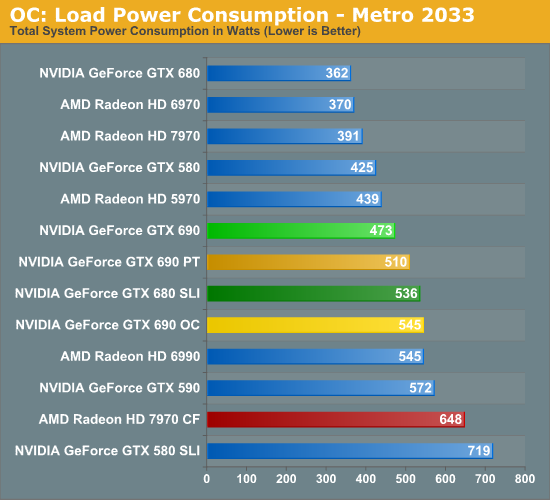

As expected, merely increasing the power target to 135% was enough to increase the GTX 690’s power consumption, though overclocking further adds to that. Even with the power target increase however, the power consumption at the wall for the GTX 690 is still lower than the GTX 680 SLI by over 20W, which is quite impressive. As we’ll see in our section on performance this is more than enough to erase the GTX 690’s performance gap, meaning at this point its still consuming less power than the GTX 680 SLI while offering better performance than its dual-card cousin.
It’s only after outright overclocking that we finally see power consumption equalize with the GTX 680 SLI. The overclocked GTX 690 is within 10W of the GTX 680 SLI, though as we’ll see the performance is notably higher.
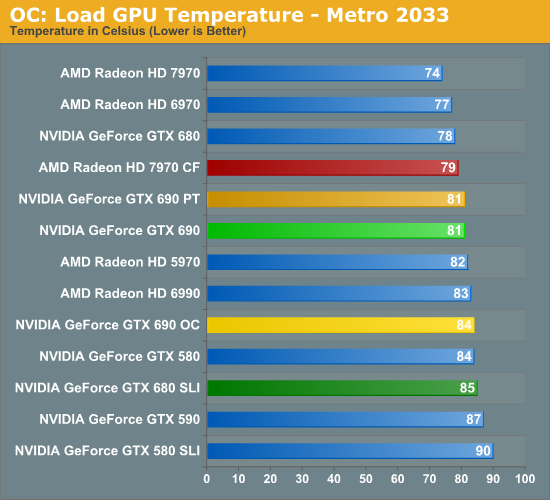
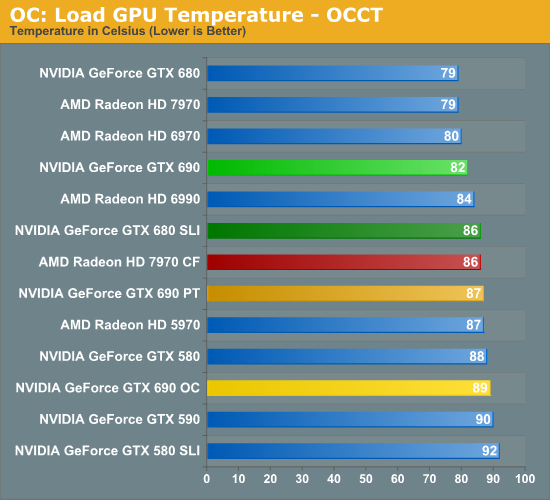
What does playing with clocks and the power target do to temperatures? The impact isn’t particularly bad, though we’re definitely reaching the highest temperatures we really want to hit. For the GTX 690 PT things are actually quite good under Metro, with the temperature not budging an inch even with the higher power consumption. Under OCCT however temperatures have risen 5C to 87C. Meanwhile the GTX 690 OC reaches 84C under Metro and a toasty 89C under Metro. These should be safe temperatures, but I would not want to cross 90C for any extended period of time.
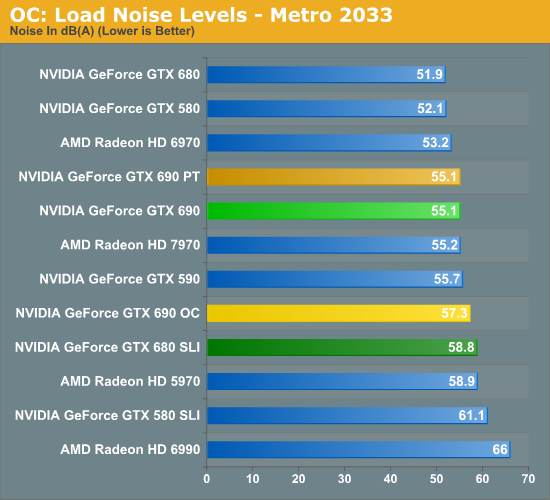
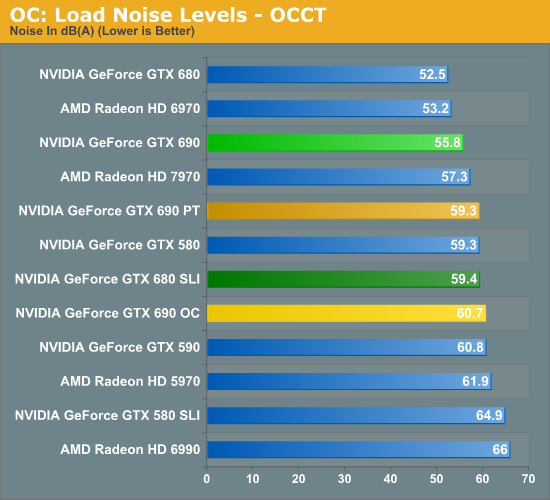
Finally we have load noise. Unsurprisingly, because load temperatures did not go up for the GTX 690 PT under Metro load noise has not gone up either. On the other hand load noise under OCCT has gone up 3.5dB, making the GTX 690 PT just as loud as our GTX 680 SLI in its adjacent configuration. In practice the noise impact from raising the power target is going trend closer to Metro than OCCT, but Metro is likely an overly optimistic scenario; there’s going to be at least a small increase in noise here.
The GTX 690 OC meanwhile approaches the noise level of the GTX 680 SLI under Metro, and shoots past it under OCCT. Considering the performance payoff some users will no doubt find this worth the noise, but it should be clear that overclocking like this means sacrificing the stock GTX 690’s quietness.










200 Comments
View All Comments
JPForums - Thursday, May 3, 2012 - link
Not mine. I'm running a 1920x1200 IPS.
1920x1200 is more common in the higher end monitor market.
A quick glance at newegg shows 16 1920x1200 models with at 24" alone. (starting at $230)
Besides, I can't imagine many buy a $1000 dollar video card and pair it with a single $200 display.
It makes more sense to me to check 1920x1200 performance than 1920x1080 for several reasons:
1) 1920x1200 splits the difference between 16x10 and 25x14 or 25x16 better than 1920x1080.
1680x1050 = ~1.7MP
1920x1080=~2MP
1920x1200=~2.3MP
2560*1440=~3.7MP
2560x1600=~4MP
2) People willing to spend $1000 for a video card are generally in a better position to get a nicer monitor. 1920x1200 monitors are more common at higher prices.
3) They already have three of them around to run 5760x1200. Why go get another monitor?
Opinionated Side Points:
Movies transitioned to resolutions much wider than 1080P long ago. A little extra black space really makes no difference.
1920x1200 is a perfectly valid resolution. If Nvidia is having trouble with it, I want to know. When particular resolutions don't scale properly, it is probable that there is either a bug or shenanigans are at work in the more common resolutions.
I prefer using 1920x1200 as a starting point for moving to triple screen setups. I already thing 1920x1080 looks squashed, so 5760x1080 looks downright flattened. Also 3240x1920 just doesn't look very surround to me (3600x1920 seems borderline surround).
CeriseCogburn - Saturday, May 5, 2012 - link
There are only 18 models available in all of newegg with 1920x1200 resolution - only 6 of those are under $400, they are all over $300.+
There are 242 models available in 1920x1080, with nearly 150 models under $300.
You people are literally a bad joke when it comes to even a tiny shred of honesty.
Lerianis - Sunday, May 6, 2012 - link
I don't know about the 'sadly' there in all honesty. I personally like 1920*1080 better than *1200, because nearly everything is done in the former resolution.Stuka87 - Thursday, May 3, 2012 - link
Who buys a GTX690 to play on a 1080P display? Even a 680 is overkill for 1080. You can save a lot of money with a 7870 and still run everything out there.vladanandtechy - Thursday, May 3, 2012 - link
Stuka i agree with you.....but when you buy such a card....you think in the future....5 maybe 6 years....and i can't gurantee that we will do gaming in 1080p then:)....retrospooty - Thursday, May 3, 2012 - link
"Stuka i agree with you.....but when you buy such a card....you think in the future....5 maybe 6 years....and i can't gurantee that we will do gaming in 1080p then:)...."I have to totally disagree with that. Anyone that pays $500+ for a video card is a certain "type" of buyer. That type of buyer will NEVER wait 5-6 years for an upgrade. That guy is getting the latest and greatest of every other generation, if not every generation of cards.
vladanandtechy - Thursday, May 3, 2012 - link
You shouldn't "totally disagree".......meet me...."the exception"....i am the type of buyer who is looking for the "long run"....but i must confess....if i could....i would be the type of buyer you describe....cyaorionismud - Thursday, May 3, 2012 - link
retrospooty and I mean you no disrespect, but if you're spending $500 and buying for the "long run," you're doing it wrong.If you had spent $250, you could have 80% of the performance for 2.5 years, then spend another $250 and have 200% of the performance for the remaining 2.5 years.
von Krupp - Thursday, May 3, 2012 - link
Don't say that.I bought two (2) HD 7970s on the premise that I'm not going to upgrade them for a good long while. At least four years, probably closer to six. I ran from 2005 to 2012 with a GeForce 7800GT just fine and my single core AMD CPU was actually the larger reason why I needed to move on.
Now granted, I also purchased a snazzy U2711 just so the power of these cards wouldn't go to waste (though I'm quite CPU-bound by this i7-3820), but I don't consider dropping AA in future titles to maintain performance to be that big of a loss; I already only run with 8x AF because , frankly, I'm too busy killing things to notice otherwise. I intend to drive this rig for the same mileage. It costs less for me to buy the best of the best at the time of purchase for $1000 and play it into the ground than it is to keep buying $350 cards to barely keep up every two years, all over a seven year duration. Since I now have this fancy 2560x1440 resolution and want to use it, the $250-$300 offerings don't cut it. And the, don't forget to adjust for inflation year over year.
So yes, I'm going to be waiting between 4 and 6 years to upgrade. Under certain conditions, buying the really expensive stuff is as much of an economical move as it is a power grab. Not all of us who build $3000 computers do it on a regular basis.
P.S. Thank you consoles for extending PC hardware life cycles. Makes it easier to make purchases.
Makaveli - Thursday, May 3, 2012 - link
lol agree let put a $500 videocard with a $200 TN panel at 1920x1080 umm ya no!